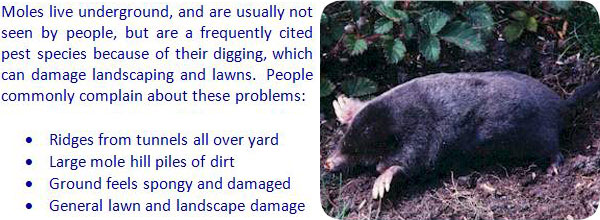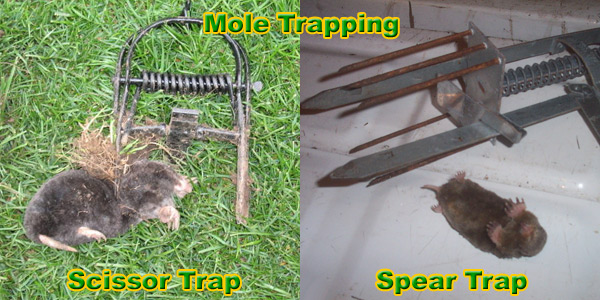- info@wildlifeanimalcontrol.com
Call us for help in your town
Wildlife Control Education
Mole Trapping - How To Trap

Need mole removal in your hometown? We service over 500 USA locations! Click here to hire us in your town and check prices - updated for year 2020.
How To Trap A Mole
Moles are very interesting creatures that can cause a lot of damage in agricultural fields and in domestic garden situations too. Some people will be frustrated with the loss of a large part of a root vegetable crop, while others will find the unsightly molehills in the middle of a manicured lawn to be hugely frustrating. Dealing with a mole problem has been something that people have tried to do for centuries, and the fact that moles very rarely reach the surface has meant that it is an art that is still being perfected.
The Different Types Of Mole Traps
The vast majority of mole traps will be lethal ones, although this is often because the work involved with the live trapping of moles is hugely difficult, and will often prove to be unsuccessful. Because moles live their lives underground, the majority of mole traps will be created in a vertical method that will have a handle or indicator showing above the ground, with the rest of the trap below the ground.
There are two main types of lethal traps that are used to deal with moles, and the first type is the barrel trap. In this instance a metal cylinder or half cylinder is inserted into a mole tunnel. If this is an active tunnel then the trap will be triggered when the mole moves in to the barrel and a catching loop will fasten very tightly around the mole killing it quickly. It is possible to have a barrel trap that can catch one mole at each end of the barrel, but this will rarely happen outside of mating season.

The second common type of mole trap is the scissor trap, which is once again inserted into an active mole tunnel. There will be a trigger ring hanging in the centre of the trap that will be moved by the mole’s nose, thus causing both sides of the trap to quickly snap together killing the mole instantly. This is a one-use trap, but because moles usually live alone this isn’t a problem.
Locating The Trap In The Right Place
One of the most difficult aspects of mole trapping is learning how to get the trap in the right place. There is no doubt that the key is getting the trap into the right part of an active mole tunnel, but achieving this is the hard part. Many professional trappers will have spent many years identifying the signs of a live tunnel. A molehill is of course a sign of a recently used tunnel, and there will often be visible signs of where the mole tunnel is leading.
Once you have found the live mole tunnel, it is important to make sure there is no impediment that could prevent the trap from closing around the mole. Ensuring that the tunnel’s sides are widened a little around the trap, and that there are no stones in the way will help make sure that when the mole does trigger the trap, it does work successfully.
Handling Moles
The majority of people that will be handling moles that have been trapped will actually be handling carcasses, and in this instance wearing gloves to prevent skin contact with the mole is helpful. Moles can carry parasites so it is best to try and avoid contact, and double bagging the carcasses before disposing of them will help to keep other animals from scenting the dead moles.
For those who do come across a live mole, it is worth bearing in mind that they will not take kindly to being handled by humans, and they do have strong claws that are generally used for digging that can damage an individual’s hands.
More in-detail how-to mole removal articles:
Information about how to kill a mole - with poison or other methods.
Information about how to keep moles away - prevention techniques.
Information about how to catch a mole - remove one stuck in the house.
Information about mole repellent - analysis of types and effectiveness.
This site is intended to provide mole education
about how to trap a mole in your yard or lawn or
property and and information about mole trapping, so that you can make an informed decision
if you need to deal with a mole problem. This site provides many mole control articles and strategies, if
you wish to attempt to solve the problem yourself. If you are unable to do so, which is likely with many
cases of mole removal, please go to the home page and click the USA map, where I have wildlife removal experts
listed in over 500 cites and towns, who can properly help you with your nuisance mole.
Click here to
read more about how to get rid of moles.

















